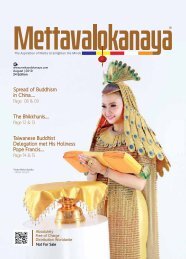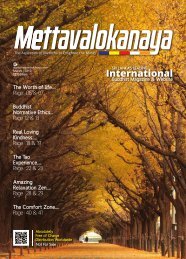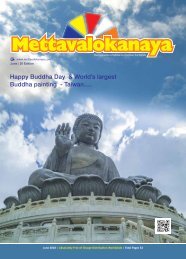Mettavalokanaya_Magazine_October_2017
“Mettavalokanaya” International Buddhist Magazine has been successfully distributed to 40 countries including all districts across Sri Lanka and now “Mettavalokanaya” is Sri Lankan Most Popular & Leading monthly Buddhist Magazine.
“Mettavalokanaya” International Buddhist Magazine has been successfully distributed to 40 countries including all districts across Sri Lanka and now “Mettavalokanaya” is Sri Lankan Most Popular & Leading monthly Buddhist Magazine.
Create successful ePaper yourself
Turn your PDF publications into a flip-book with our unique Google optimized e-Paper software.
The Power of creation or Sankhara….<br />
Most Venerable Dr. Bhiksuni Ming Yu<br />
The President - Chinese Young Buddhist Association in Taiwan & the Honorary Adviser<br />
of the World Alliance of Buddhists (WAB) and President of the Outstanding Women in<br />
Buddhism Awards<br />
The Buddha<br />
talks about<br />
various ways of<br />
dealing<br />
with<br />
distraction….<br />
The mind has a basic habit, which is to create things. In<br />
fact, when the Buddha describes causality, how experiences<br />
come about, he says that the power of creation or sankhara—<br />
the mental tendency to put things together—actually comes<br />
prior to our sensory experience. It’s because the mind is<br />
active, actively putting things together, that it knows things.<br />
The problem is that most of its actions, most of its<br />
creations, come out of ignorance, so the kind of knowledge<br />
that comes from those creations can be misleading. For this<br />
reason, what you want to do in the process of meditation is<br />
to back up, to get down as close to this process of creation<br />
as you can, to see if there’s a way to do it skillfully that leads<br />
to knowledge, that leads you to a point that breaks through<br />
ignorance. And this means, instead of building up a lot of<br />
things, you let things fall apart so you can get down to exactly<br />
where these basic forces in the mind are putting things<br />
together.<br />
Now it so happens that when we bring the mind to<br />
the breath, we have all these basic forces right here in their<br />
most elemental forms. The breath is the factor that fashions<br />
the body. It’s what they call kaya‐sankhara or the “physical<br />
putting‐together.” The breath is what puts life together in<br />
the body. If it weren’t for the breath here, things would start<br />
falling apart really quickly.<br />
Then there’s verbal fabrication, vaci‐sankhara, the act of<br />
putting things in words. The two basic verbal sankharas are<br />
directed thought and evaluation, and you’ve got those rights<br />
here, too. You direct your thoughts to the breath and then<br />
evaluate the breath: How does the breath feel? Does it feel<br />
good? If it does, stay with it. If it doesn’t feel good, you can<br />
change it. This is about the most basic level of conversation<br />
you can have with yourself: “Does this feel good or not?<br />
Comfortable or not? Yes. No.”<br />
And then you work with that. What are you working<br />
with? You’re working with mental fabrication, citta‐sankhara,<br />
which covers feeling and perception: feelings of pleasure,<br />
pain, of neither pleasure nor pain. And then perceptions are<br />
the labels the mind gives to things: “This is pleasant. This is<br />
painful. This is this and that is that.”<br />
When you’ve got the mind with the breath, you’ve got<br />
all of these things brought together: the feelings that come<br />
with the breath, the perceptions that label the breath: “Now<br />
the breath is coming in. Now the breath is going out. Now the<br />
mind is like this. Now it’s like that.” The directed thought and<br />
the evaluation are there as well, keeping you focused on the<br />
breath and on evaluating the breath.<br />
So these things are all together. If you stray away from<br />
here, you’re usually straying away into distraction, into the<br />
realm of further elaboration, in which you lose this basic<br />
frame of reference and create a whole other one. It’s what<br />
they call “becoming” in the texts, when you create other<br />
worlds in the mind. Once you get into those other worlds, you<br />
lose touch with the process of creation, you lose touch with<br />
how becoming is brought together. So you’ve got to learn how<br />
to take those worlds of distraction—and the processes that<br />
form them—apart.<br />
The Buddha talks about various ways of dealing with<br />
distraction. Once you’ve realized you’ve left your original<br />
frame of reference, you bring yourself back. In other words,<br />
you remind yourself. In some cases, the simple act of reminding<br />
is enough to disperse that other little world you’ve created for<br />
you and come back to this one.<br />
Other times you have to reflect actively on the<br />
drawbacks of that other world, of the thinking that creates it,<br />
especially if its thinking imbued with lust, aversion, delusion,<br />
or harmfulness. You’ve got to remind yourself, “What would<br />
happen if I thought about this for a while?” Well, you’d<br />
create certain habits in the mind, and once those habits are<br />
imbedded in the mind they lead to actions that can create all<br />
kinds of problems. When you see the drawbacks of that kind<br />
of thinking, you say, “I don’t need that. I’ve had enough of that<br />
in my life.” You drop it and come back to the breath.<br />
18 I <strong>Mettavalokanaya</strong> I <strong>October</strong> I <strong>2017</strong> I www.meththawalokanaya.com<br />
www.meththawalokanaya.com I <strong>2017</strong> I <strong>October</strong> I <strong>Mettavalokanaya</strong> I 19

















